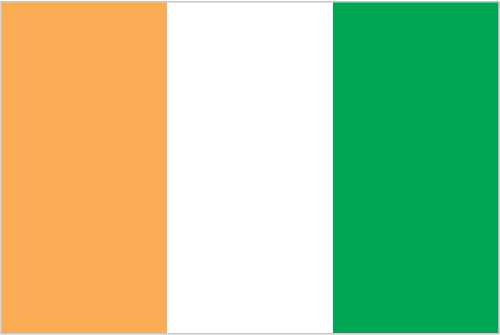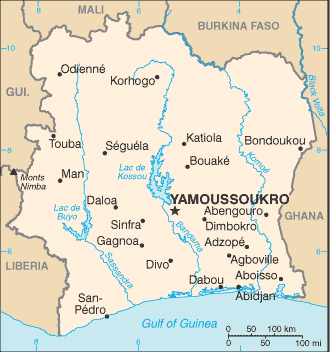Cote d’Ivoire
Free and always accurate driving directions, Google Maps, traffic information for Cote d’Ivoire (CI). Explore satellite imagery of Yamoussoukro, the capital city of Cote d’Ivoire, on the Google Maps of Africa below.
Cote d’Ivoire (GPS: 8 00 N, 5 00 W) located in Western Africa, bordering the North Atlantic Ocean, between Ghana and Liberia. The country’s area measurements are total: 322,463 sq km; land: 318,003 sq km, water: 4,460 sq km. This sovereign state is slightly larger than New Mexico. The total irrigated land is 730 sq km (2012).
One of the essential features of Cote d’Ivoire: Most of the inhabitants live along the sandy coastal region. Apart from the capital area, the forested interior is sparsely populated.
It’s significant, and simultaneously, the principal city, Yamoussoukro’s GPS coordinates are 6 49 N 5 16 W. Yamoussoukro’s local time is 5 hours ahead of Washington DC during Standard Time. The capital’s time difference: UTC 0, note; time difference: UTC 0 (5 hours ahead of Washington DC).
For more information on Cote d’Ivoire, please scroll down below the Google Maps.
Google Maps Cote d’Ivoire and Yamoussoukro, Africa
About Cote d’Ivoire in detail
| Flag of Cote d’Ivoire | Map of Cote d’Ivoire |
|---|---|
 |
 |
Close ties to France following independence in 1960, the development of cocoa production for export, and foreign investment made Cote d’Ivoire one of the most prosperous West African states. Still, they did not protect it from political turmoil. In December 1999, a military coup – the first ever in Cote d’Ivoire’s history – overthrew the government. Junta leader Robert GUEI attempted to rig the elections held in late 2000 and declared himself the winner. Popular protest forced him to step aside, and an election brought Laurent GBAGBO into power. Ivoirian dissidents and disaffected military members launched a failed coup attempt in September 2002 that developed into a rebellion and then a civil war.
In 2003, a cease-fire resulted in the country divided with the rebels holding the north, the government the south, and peacekeeping forces a buffer zone. In March 2007, President GBAGBO and former New Forces rebel leader Guillaume SORO signed an agreement in which SORO joined GBAGBO’s government as prime minister. The two agreed to reunite the country by dismantling the buffer zone, integrating rebel forces into the national armed forces, and holding elections. Difficulties in preparing electoral registers delayed balloting until 2010. In November 2010, Alassane Dramane OUATTARA won the presidential election over GBAGBO, but GBAGBO refused to hand over power, resulting in a five-month resumption of violent conflict.
In April 2011, after widespread fighting, GBAGBO was formally forced from office by armed OUATTARA supporters with UN and French forces’ help. OUATTARA won a second term in 2015 and is focused on rebuilding the country’s economy and infrastructure while reforming the security forces. The UN peacekeeping mission departed in June 2017. GBAGBO was in The Hague on trial for crimes against humanity but was acquitted in January 2019. Cote d’Ivoire is scheduled to hold presidential elections in November 2020.
Cote d’Ivoire’s names conventional long form: the Republic of Cote d’Ivoire, traditional short form: Cote d’Ivoire, local long way: Republique de Cote d’Ivoire, local transient state: Cote d’Ivoire. Note: pronounced coat-div-whar, former: Ivory Coast, etymology: name reflects the intense ivory trade in the region from the 15th to 17th centuries. The name reflects the low ivory trade in the area from the 15th to the 17th centuries.
Cote d’Ivoire’s terrain is typically mostly flat to undulating plains; mountains in the northwest. The country’s mean elevation: 250 m, elevation extremes; lowest point: Gulf of Guinea 0 m, highest point: Monts Nimba 1,752 m.
The general climate in the country; tropical along the coast, semiarid in the far north: three seasons – warm and dry (November to March), hot and dry (March to May), hot and wet (June to October).
The total number of border countries is 5, Burkina Faso 545 km, Ghana 720 km, Guinea 816 km, Liberia 778 km, Mali 599 km are the neighboring nations with the indicated border lengths. Cote d’Ivoire’s coastline is 515 km, while its marital claims are: territorial sea: 12 nautical miles, exclusive economic zone: 200 nautical miles, continental shelf: 200 nautical miles. Waterways: 980 km (navigable rivers, canals, and numerous coastal lagoons) (2011). Land use: agricultural land: 64.8%; arable land 9.1%; permanent crops 14.2%; permanent pasture 41.5%; forest: 32.7%; other: 2.5% (2011 estimate).
The population in Cote d’Ivoire 26,260,582 (July 2018 estimate), urban population: 54.2% of total population (2015), major urban area’s population: YAMOUSSOUKRO (capital) 259,000 (2014); ABIDJAN (seat of government) 4.86 million; Bouake 762,000 (2015), while Cote d’Ivoire has N/A. Their spoken languages are French (official language), 60 native dialects, of which Dioula is the most widely spoken. Main religions in Cote d’Ivoire are Muslim 40.2%, Catholic 19.4%, Evangelical 19.3%, Methodist 2.5%, other Christian 4.5%, animist or no religion 12.8%, other religion/unspecified 1.4% (2011-12 estimate). Note: the majority of foreign migrant workers are Muslim (72%) and Christian (18%) (2014 estimate). The nation uses civil law system based on the French civil code, judicial review of legislation held in the Constitutional Chamber of the Supreme Court. It is a(n) presidential republic, National holiday(s) Independence Day, 7 August (1960).
Economic overview for the country: For the last five years, Cote d’Ivoire’s growth rate has been among the world’s highest. Cote d’Ivoire is heavily dependent on agriculture and related activities, which engage roughly two-thirds of the population. Cote d’Ivoire is the world’s largest producer and exporter of cocoa beans and a significant producer and exporter of coffee and palm oil. Consequently, the economy is highly sensitive to fluctuations in international prices for these products and climatic conditions.
Cocoa, oil, and coffee are the country’s top export revenue earners, but the government has targeted agricultural processing of cocoa, cashews, mangoes, and other commodities as a high priority. Mining gold and exporting electricity are growing industries outside agriculture. Following the end of more than a decade of civil conflict in 2011, Cote d’Ivoire has experienced a boom in foreign investment and economic growth. In June 2012, the IMF and the World Bank announced $4.4 billion in debt relief for Cote d’Ivoire under the Highly Indebted Poor Countries Initiative.
Natural resources of Cote d’Ivoire: petroleum, natural gas, diamonds, manganese, iron ore, cobalt, bauxite, copper, gold, nickel, tantalum, silica sand, clay, cocoa beans, coffee, palm oil, hydropower.
Main export partners for Cote d’Ivoire, Africa are US 8.5%, Netherlands 6.2%, France 5.6%, Germany 5.6%, Nigeria 5.5%, Burkina Faso 5.5%, Belgium 5.3%, India 4.6%, Ghana 4.4%, Switzerland 4.1% (2015) for cocoa, coffee, timber, petroleum, cotton, bananas, pineapples, palm oil, fish, while the main import partners for the country are: Nigeria 21.9%, China 14.4%, France 11.4%, Bahamas, The 5% (2015) for fuel, capital equipment, foodstuffs.
When you visit this country in Africa, consider the natural hazards in Cote d’Ivoire: Coast has heavy surf and no natural harbors, during the rainy season torrential flooding is possible, while infectious diseases are a degree of risk: very high food or waterborne diseases: bacterial diarrhea, hepatitis A, and typhoid fever vectorborne diseases: malaria, dengue fever, and yellow fever water contact disease: schistosomiasis animal contact disease; rabies respiratory disease: meningococcal meningitis (2016). Also, note that Cote d’Ivoire faces the following environmental issues: Deforestation (most of the country’s forests – once the largest in West Africa – have been heavily logged), water pollution from sewage, and industrial, mining, and agricultural effluents.
You may also be interested in the countries next to Cote d’Ivoire around its total: 3,458 km border, like Burkina Faso, Ghana, Guinea, Liberia, Mali.
